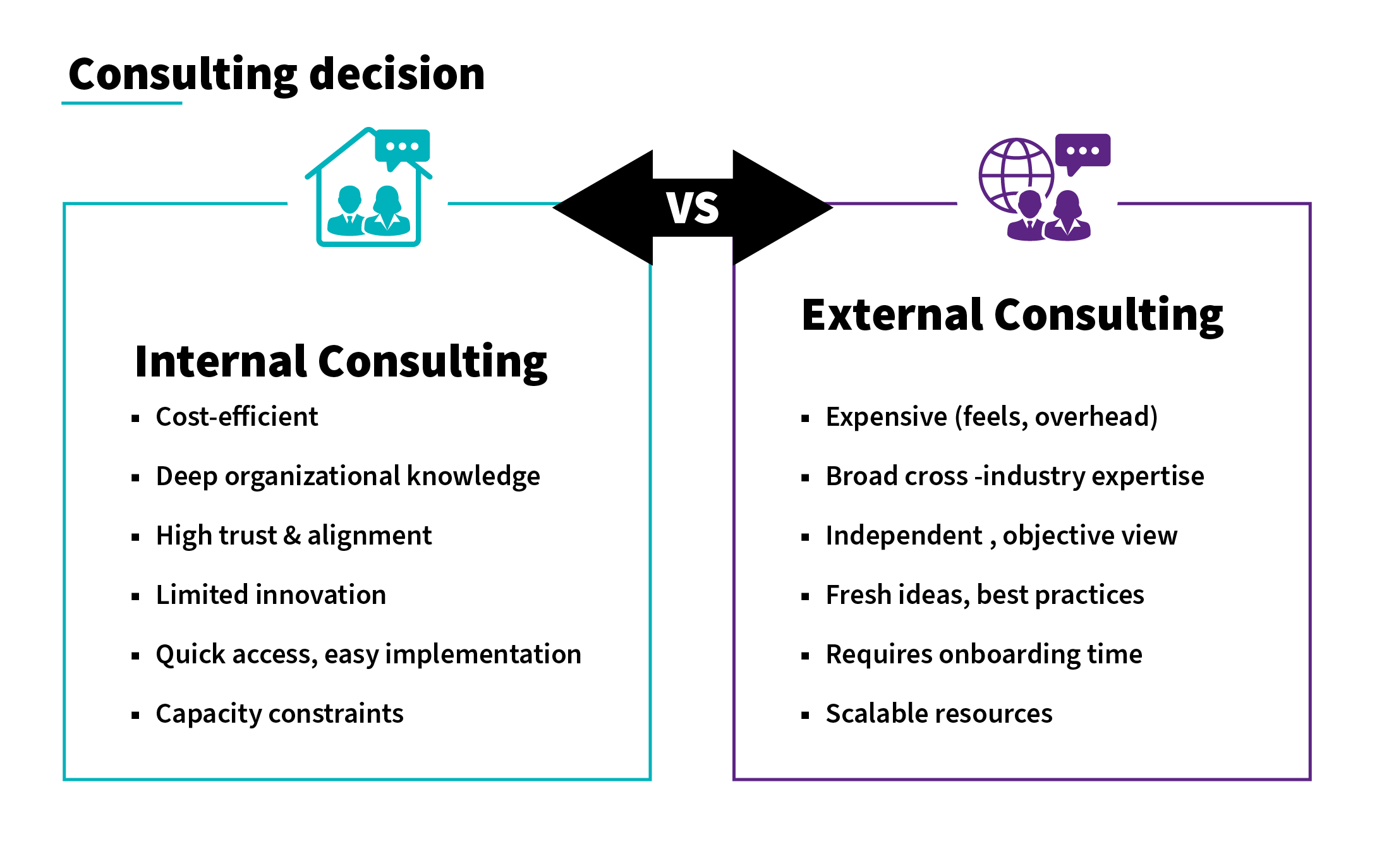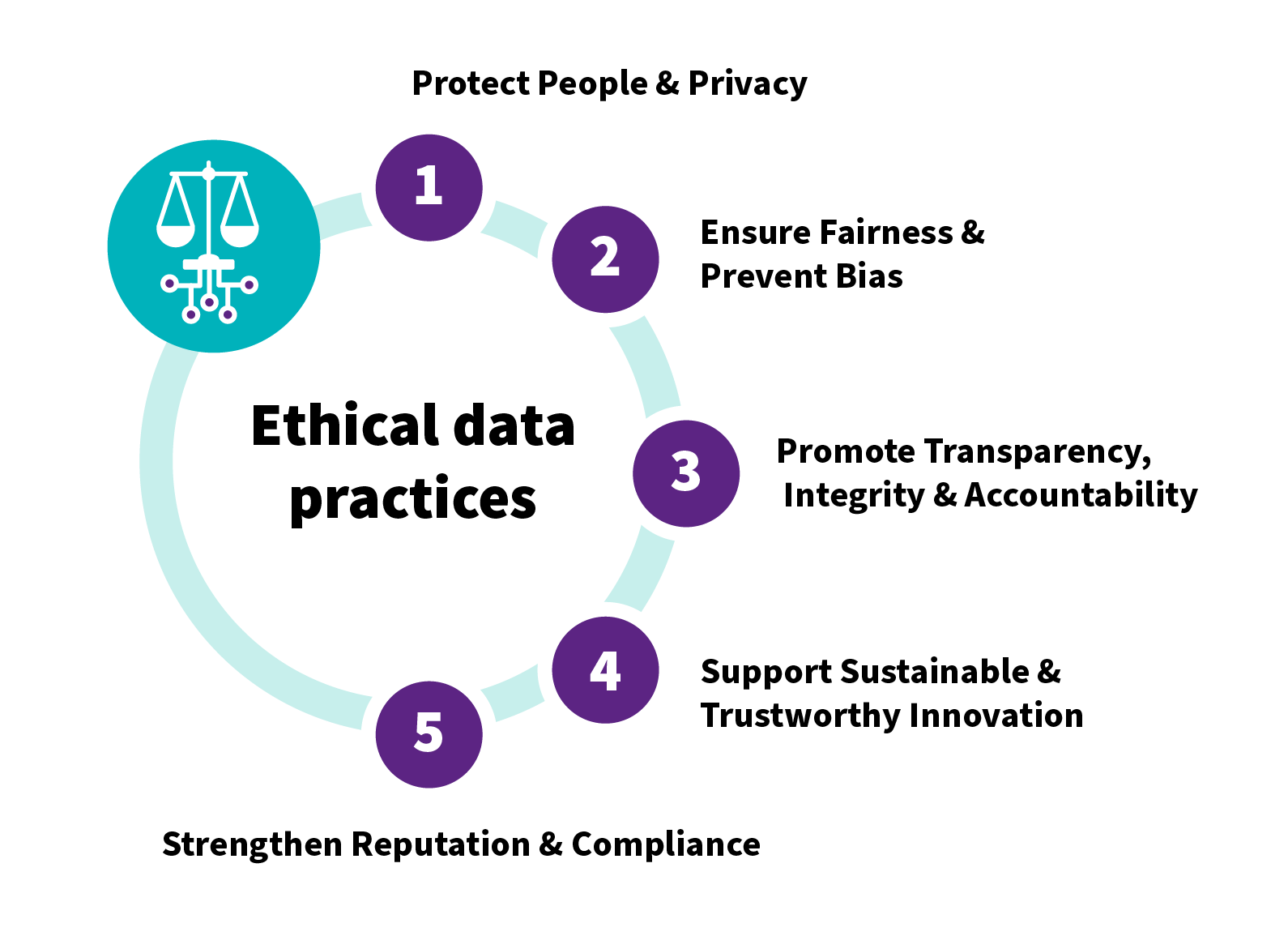Activities
1. Consolidate the data analysis
This activity centres on unifying insights from your prototype by harmonising and standardising findings, refining datasets, and building coherent outputs—such as reports or visual summaries—to inform decisions. Look to comprehensive guides on data consolidation techniques, ETL tools, and best practices (e.g., ETL/ELT pipelines, data warehouses, quality controls). This:
- Helps navigate complexity by turning fragmented PoC outputs into structured, reliable datasets.
- Ensures clarity, presenting a consolidated narrative that’s actionable and stakeholder-ready.
- Provides practical tools—ETL frameworks and platforms—for reproducibility and scalability if the prototype evolves into production.
2. Consulting Decision
Before deciding whether to engage external consulting or to move forward without, initiatives should assess their internal capabilities, estimated project complexity and timeline, as well as the overall resource availability and allocation, to reflect which decision is most suitable for the initiative.

While external consultants can provide specialised expertise and know-how and accelerate development, it may also increase project costs and require stronger coordination and collaboration for all involved parties. Further, the decision to proceed with external consulting, comes with external effects and influence on the project. Earlier projects and studies [1] have shown, that many of the problems which arise in this context can be traced back to different values, such as the value of agility or transparency, and differing expectations. To minimise and prevent the occurrence of such problems, practices like regular meetings to strengthen the communication, an initial kick-off to get to know each other and lay out expectations and risk mapping on both sides are recommended.
On the other hand, moving forward internally ensures greater cost efficiency and control, as the scope of the project, the implementations and all related aspects are managed under one roof. However, other potential limitations, such as time management and human resources, the limitation of manageable scope and limited internal expertise should be considered.
Decide on proceeding with external consulting
Engaging external consultation for your initiative requires a structured approach to ensure alignment with your organisation’s objectives. To do so, these key steps can help you on the procurement of external consulting:
- Summarise defined wanted requirements for your solution: Clearly form and articulate the specific need and goals of your project. This involves detailing the scope, desired outcomes and goals, technical specifications and any already identified constraints (e.g. refer to “Conceptualisation & Proof of Value”). A well-defined set of requirements and structured outline will not only guide your initiative but also serve as a foundation for evaluating potential consultants.
- Prepare the bidding process: Begin by preparing a comprehensive request for proposals (RFP) which outlines your previously set project’s requirements, expectations and evaluation criteria. Ensure that the bidding process is transparent and adheres to procurement policies.
- Set a strong timeline and evaluation criteria: Lay out clear deadlines for the selection process. These processes include the proposal submission date, the end of the evaluation and the final decision. For the evaluation and subsequent decision, defining objective criteria will help you in facilitating a fair process. Criteria could include experience, proposed methodological approach or overall costs.
Further guidelines and resources to assist the proceeding with external consulting are offered by the European Commission Directorate-General for Internal Market, Industry, Entrepreneurship and SMEs: https://single-market-economy.ec.europa.eu/single-market/public-procurement_en.
Decide on proceeding without external consulting
With the decision to proceed without external consulting, the choice is made to rely on internal expertise, resources and processes. This approach offers greater control of the project’s directions, has the potential to foster internal knowledge growth and overall can be more cost-saving in the long-run. While moving an initiative along without external consulting can empower internal teams, it also comes with challenges. Limited capacity, skill gaps or internal siloes can affect the project and lead to delays or reduced quality. The outlined key steps are helpful to consider when initiating the internal development process.
Key steps include:
- Assessment of internal expertise and capacity: As a first foundation, a thorough assessment of existing capabilities, potential skill gaps and resource availability should be the basis to execute the PoC effectively. Should gaps exists, consider trainings/ upskilling, as well as reallocating internal resources.
- Initiate the internal development process: Set a structured internal approach for PoC development and establish dedicated roles and work teams, workflows and iterative feedback loops
- Define a clear timeline and milestones: Establish a structured plan outlining objectives, milestones and key performance indicators (KPIs) along the way to ensure measured progress. This helps to ensure alignment across all team members and maintains project momentum
- Leverage existing workflows and frameworks: Utilise internal knowledge repositories, individual know how and past project experiences to streamline development and minimize redundant efforts.
3. Identify and be aware of ethical challenges
In data-driven projects, ethics isn’t just a post-launch or one-time concern, it starts at the very beginning and remains a continuous responsibility throughout an entire project and beyond. While law may set the minimum standards, ethical responsibility often extends further, shaping long-term trust, social acceptance and fairness. Ethical lapses can entrench bias, violate privacy and cause societal harm long before a project is ever launched and also long after a project is over.
Key ethical considerations in the prototyping stages include data privacy, transparency, bias and inclusion. Even at early stages, using synthetic, public or real user data demands strict and stringent privacy-by-design practices. Transparency and informed consent remain crucial, even with publicly accessible data. Ethical guidelines from bodies like the British Psychological Society and the Association of Internet Researches recommend informing individuals on how data will be used and, where possible, offering opt-out options before publishing results integrating data into other systems. Bias in data (and algorithms) is another major concern. Training on skewed datasets – such as those shaped by historically discriminatory practices – can reinforce systemic inequities.
Finally, data-driven prototyped may unintentionally exclude underrepresented groups by overrepresenting digitally dominant voiced. The digital exclusion can have serious implications when early design choices affect access to essential services or rights.
Ethical development practices should therefore be proactive and participatory:
- Include interdisciplinary and diverse stakeholder input during prototyping
- Conduct ethical impact assessments akin to Data Protection Impact Assessments (DPIAs), even when legally not required
- Engage with official frameworks such as the EU Ethics Guidelines for Trustworthy AI (https://digital-strategy.ec.europa.eu/en/library/ethics-guidelines-trustworthy-ai) and explore transparency tools like the OECD AI Principles (https://oecd.ai/en/ai-principles)

4. Tackle and be aware of legal challenges
Especially in early stages of data-driven projects, legal challenges are essential to consider, as they can become critical if not addressed proactively. With data-driven initiatives moving along with tasks of collecting, processing and analysing data, they must navigate a complex framework of regulations, ethical considerations and further compliance requirements. With the help of proven practices, guidance and practical resources, these challenges can and should be tackled and cleared early on, ensuring a secure foundation for further development.
Some established best practices include:
- Conduct Comprehensive Data Mapping
To understand the legal requirements to adhere, identifying and documenting all relevant data flows is essential. This aids in pinpointing potential compliance gaps.
→ DO: Collect only the necessary data to your specific purpose. By limiting the data collection, the exposure to legal risks is reduced
→ DON’T: Collect all kinds of plausible or “just in case” data for your project without being sure about their purpose.
- Establish Robust Data Governance Frameworks
In previous workflows roles and responsibilities should have been set. These roles should also include procedures for data management and policies to adhere, helping in ensuring accountability. For any data-driven project it is essential that all involved staff members are aware of data protection laws and organisational, as well as national policies. Regular training can foster a culture of compliance and reduce the likelihood of inadvertent breaches.
→ DO: Define clear roles, responsibilities and accountability for data handling. Create accessible policies and ensure their enforcement
→ DON’T: Leave governance vague or informal, the clearer, the better. Also, don’t overlook smaller teams, individuals or possible subsidiaries to your project, governance should apply everywhere in your initiative
- Engage Legal and Compliance Experts
Collaborate with legal professionals who specialise in data protection to stay updated on evolving regulations and interpret more complex legal requirements more accurately.
→ DO: Consult internal or external legal experts in the early stages of your project. Use their guidance to interpret complex regulations and tailor your compliance
→ DON’T: Rely on generalist knowledge or delay consultations until issues arise. Proactive legal involvements prevent not only timely but also costly missteps.
As one of the most comprehensive and influential data protection laws, the European Union’s General Data Protection Regulation (GDPR) imposes stringent requirements on data collection, processing and storage, with non-compliance resulting in fines to up to 4% of annual global turnover or 20 million €. To tackle and clear legal challenges and build a strong foundation for responsible data practices, a variety of resources offer valuable insights and trainings.
- European Data Protection Board (EDPB) Guidelines: Offer guidance on the application of GDPR, including assessments of legitimate interests and other key concepts
https://www.edpb.europa.eu/our-work-tools/our-documents/publication-type/guidelines_en - Data.europa academy: Providing free learning materials about open data in Europe, including courses on data protection and compliance https://data.europa.eu/de/academy
- European Commission’s Data Protection Academy: Supports newly established data protection authorities with training and resources to enhance their understanding of data protection laws
https://commission.europa.eu/law/law-topic/data-protection/international-dimension-data-protection/data-protection-academy-0_en
Resources
D4A Training Modules
- VIVES: Introduction to ethics
- VIVES: What is ethics and why should you care about it
- VIVES: How you talk about technology is key
- VIVES: How to implement ethics in my own project
- VIVES: Data protection in data-driven municipalities
- Intercommunale Leiedal: Proof of Concept
Academic Papers
"To go further" - Insights of a Method
- VIVES: Flash Cards on Data Ethics
- D4A Regional Data-Ecosystem Processflow by Intercommunale Leiedal
